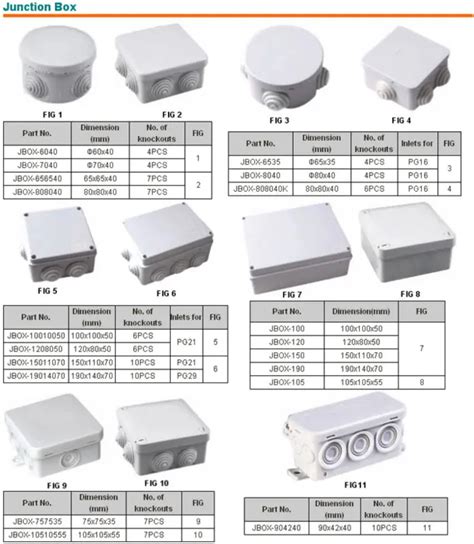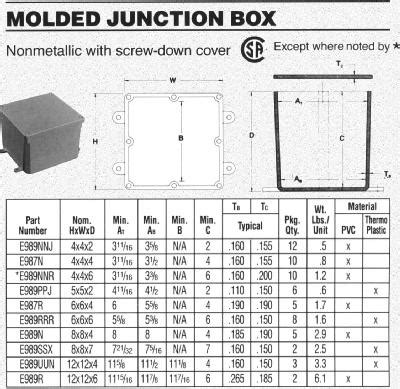different depth junction box Once the hole is cut in the wall for the box, feed the cable (or cables) out through . CNC die sinking EDM is a high-precision machining equipment widely used in mold manufacturing, aerospace, automotive parts, and other fields. Understanding its principles and working processes is cruc.
0 · standard junction box sizes
1 · pvc junction box size chart
2 · outdoor electrical junction boxes sizes
3 · nec junction box size chart
4 · junction box sizes chart
5 · junction box size in mm
6 · junction box size calculator
7 · electrical junction boxes sizes
If a rollover contribution is made to a traditional or Roth IRA that is later revoked or closed, and distribution is made to the taxpayer, enter in boxes 1 and 2a of Form 1099-R the gross distribution and the appropriate code in box 7 (Code J for a Roth IRA).
A junction box is not a special type of box but any standard electrical box used to enclose wire splices. The most commonly used box for junctions is a 4-inch square box (either metal or strong plastic), which offers ample space for making wire connections with multiple .When you install an electrical box, make sure it is flush with the surface of this .A junction box is an electrical box that allowed two or more electrical cables to .Once the hole is cut in the wall for the box, feed the cable (or cables) out through .
A junction box that is 4-by-4 inches with a 1-1/2-inch depth can hold up to 10 14 .It also prevents the cable from rubbing against the edge of the box and .
Deep junction boxes, also known as extension rings or deep switch boxes, are used when additional space is required to accommodate extra wiring or devices. These boxes . Junction boxes are square, round or octagonal in shape and can be deep or shallow. When installing these enclosures, adhere to the following guidelines: Junction boxes .

metal fabricator apprenticeship
Typical Electrical Boxes for Single Receptacles, Switches, or Splices. Typical electrical junction boxes used for receptacle installation to accommodates a single receptacle are 2" x 4" metal .Shallow pancake boxes (4 in. in diameter by 1⁄2 in. deep) are commonly used to flush-mount light fixtures. Where you’re installing GFCI receptacles or need more room for connectors and devices, use a 4S deep box. Finally, cover 4-square .Each type of electrical box is designed for a specific use. Below are the most common electrical boxes, like the outlet box, junction box, light switch box, and fan box, as well as different gang . Junction boxes are must-have units at home as they protect against electrical issues. Here are a few of the most common junction boxes and where to use them.
A junction box is not a special type of box but any standard electrical box used to enclose wire splices. The most commonly used box for junctions is a 4-inch square box (either metal or strong plastic), which offers ample space for making wire connections with multiple wires or . Whether you’re starting new construction or adding to existing wiring, understanding the different types of electrical boxes helps for a safe installation. We’ll break down the categories of electrical boxes and explain their uses. Deep junction boxes, also known as extension rings or deep switch boxes, are used when additional space is required to accommodate extra wiring or devices. These boxes have a greater depth compared to standard junction boxes, allowing for more room inside. Junction boxes are square, round or octagonal in shape and can be deep or shallow. When installing these enclosures, adhere to the following guidelines: Junction boxes are used to enclose wire splices. Wherever two electrical wires join, you should install a junction box.
Typical Electrical Boxes for Single Receptacles, Switches, or Splices. Typical electrical junction boxes used for receptacle installation to accommodates a single receptacle are 2" x 4" metal or plastic boxes of varying depth.
Shallow pancake boxes (4 in. in diameter by 1⁄2 in. deep) are commonly used to flush-mount light fixtures. Where you’re installing GFCI receptacles or need more room for connectors and devices, use a 4S deep box. Finally, cover 4-square boxes with a mud-ring cover.
Each type of electrical box is designed for a specific use. Below are the most common electrical boxes, like the outlet box, junction box, light switch box, and fan box, as well as different gang boxes, from single gang and 2 gang, up to 3 gang, 4 gang, and beyond. Junction boxes are must-have units at home as they protect against electrical issues. Here are a few of the most common junction boxes and where to use them.When you're in the market for a junction box, you'll want to consider several factors, including the type of environment, electrical load, and specific use case. Balancing these considerations can help you make an informed choice that best suits your needs. Explore the world of electrical junction boxes – their crucial role, types, installation tips, and safety measures. Uncover the power of junction boxes in securing your electrical system.
A junction box is not a special type of box but any standard electrical box used to enclose wire splices. The most commonly used box for junctions is a 4-inch square box (either metal or strong plastic), which offers ample space for making wire connections with multiple wires or .
Whether you’re starting new construction or adding to existing wiring, understanding the different types of electrical boxes helps for a safe installation. We’ll break down the categories of electrical boxes and explain their uses. Deep junction boxes, also known as extension rings or deep switch boxes, are used when additional space is required to accommodate extra wiring or devices. These boxes have a greater depth compared to standard junction boxes, allowing for more room inside. Junction boxes are square, round or octagonal in shape and can be deep or shallow. When installing these enclosures, adhere to the following guidelines: Junction boxes are used to enclose wire splices. Wherever two electrical wires join, you should install a junction box.
Typical Electrical Boxes for Single Receptacles, Switches, or Splices. Typical electrical junction boxes used for receptacle installation to accommodates a single receptacle are 2" x 4" metal or plastic boxes of varying depth.
Shallow pancake boxes (4 in. in diameter by 1⁄2 in. deep) are commonly used to flush-mount light fixtures. Where you’re installing GFCI receptacles or need more room for connectors and devices, use a 4S deep box. Finally, cover 4-square boxes with a mud-ring cover.Each type of electrical box is designed for a specific use. Below are the most common electrical boxes, like the outlet box, junction box, light switch box, and fan box, as well as different gang boxes, from single gang and 2 gang, up to 3 gang, 4 gang, and beyond.
Junction boxes are must-have units at home as they protect against electrical issues. Here are a few of the most common junction boxes and where to use them.When you're in the market for a junction box, you'll want to consider several factors, including the type of environment, electrical load, and specific use case. Balancing these considerations can help you make an informed choice that best suits your needs.
standard junction box sizes

What is the Sheet Metal Process? The process of producing sheet metal components using metal sheets is known as sheet metal forming or sheet metal fabrication. This is accomplished by bending, punching, shearing, hydroforming, and other techniques to form and cut sheets into the necessary shapes and forms.
different depth junction box|electrical junction boxes sizes